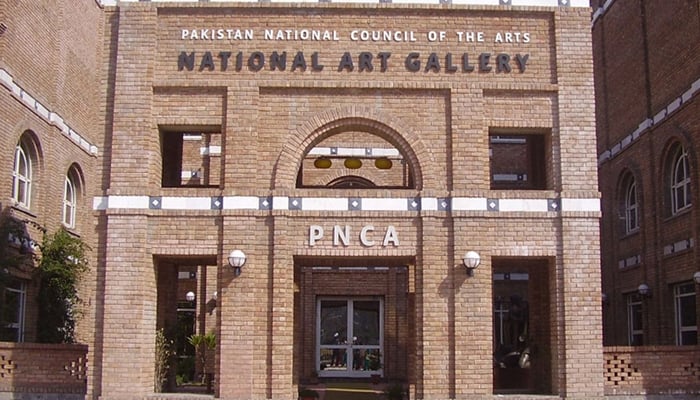
Melissa Gronlund
Mohamed Ahmed Ibrahim’s installation of 128 sculptures, Between Sunrise and Sunset, opened on Wednesday at the Venice Biennale’s National Pavilion UAE. Arranged in a thick column in the cavernous Arsenale room, the tree-like sculptures nearest to the opening are in bright colours of greens, pinks, blues and yellows. The forms remain the same but the colours change as one walks towards the back of the room, with beiges and taupes taking the place of formerly lurid shades, until the palette has totally changed into a more desolate landscape of blacks and whites.
The work, and the performative walk around it, affect the transition from day to night, as seen by the eye: from the bright colours that can be perceived in full sun to the monochromatic palette as the rods of the eyes take over.
The artwork draws on several strands that the Emirati artist has long explored, and one subject above all: Khor Fakkan. Some of Ibrahim’s earliest works, from the 1990s, were made as land art, or interventions straight into the rocky faces of the Khor Fakkan mountains. Here, for his representation of the UAE, he brings the way the light works from his home to Venice.
“I spent my childhood without a sunset,” he says. “I didn’t see a sunset till I was 6 years old. We have a different kind of shade in Khor Fakkan.”
When he was 6, Ibrahim’s family moved to Kuwait for a short period.
:quality(70)/cloudfront-eu-central-1.images.arcpublishing.com/thenational/CVMRCKWA7JC4DDBCHPWTHAPBQA.jpg?w=810&ssl=1)
The mountains of Khor Fakkan, Ibrahim explains, block the sun for about two hours before it finally sets beyond the horizon. This interstitial period creates two hours of low light, where the eye can only perceive vestiges of colour but has not fully slid into blacks, whites and greys. Between Sunrise and Sunsetanimates this curiously gradual progression, with its languorous, attenuated moment of taupes and beiges forming the middle of the installation.
The sculptures stand about 1.5 metres tall on average, slightly raised away from the viewer on a platform. Made of papier-mache, they seem painted but actually gain their colour from the paper used to create them, so that the hues are made as a part of the work itself, seeped into their being. He mixed the coloured sheaves of paper as a painter mixes paint, and also incorporated everyday, organic material from around him — leaves from trees in his garden from Khor Fakkan, tobacco, tea, coffee, and even the cardboard packaging from toys, which his grandchildren would save and give to him.
:quality(70)/cloudfront-eu-central-1.images.arcpublishing.com/thenational/2OUPJLGC6NF7VJL227H2V5BWFE.jpg?w=810&ssl=1)
In some ways, they resemble trees and animals, but Ibrahim says they represent neither. Instead, they take their own, particular shape, recognisable as his artwork more than anything else.
“Ibrahim’s work almost has a pre-lingual quality to it,” says Maya Allison, the curator of the pavilion. “His technique leads to these forms that are very visceral and derived from his memory drums, as he talks about it.”
Ibrahim studied psychology at Al Ain University, where he learnt about the mid-century idea of a memory drum, a kind of external hard drive for the brain. For Ibrahim, the memory drum has become a working concept of the memories that exist before they are linguistically understood — the colour of grass before the word “green” is known, for example.
:quality(70)/cloudfront-eu-central-1.images.arcpublishing.com/thenational/6XAEU2HVKJDSRIXKHGCZWHIY64.jpg?w=810&ssl=1)
“For his art-marking, the forms go back to his childhood, but also to that pre-memory part of his brain,” says Allison. “He’ll make forms that he then later realises were connected to something he recognised from around him, but he would never explicitly cite it as an influence.”
Allison, the director of the New York University Abu Dhabi Art Gallery, has worked with Ibrahim for several years, most notably in her exhibition But We Cannot See Them: Tracing a UAE Art Community, 1988-2008, which looked at the early artistic group that included Ibrahim, Hassan Sharif, Hussein Sharif, Abdullah Al Saadi and others.
“He was making land art when he didn’t know there was such a thing as land art,” says Allison. “He was just doing it because he wanted to. He and Hassan Sharif would say that they’re not artists, this isn’t art. This is the name that we give to what we’re doing.”
:quality(70)/cloudfront-eu-central-1.images.arcpublishing.com/thenational/JVDT7N4KTFFL3NPHZENJWYKTBY.jpg?w=810&ssl=1)
For Allison, this freedom from the question of whether they were making “art” liberated Ibrahim and his peers to create their formal experimentations.
“He has complete trust in his processes,” she says.
One of these is his study of perception. Ibrahim isolates the strange squiggly forms that appear on the eyelids — or more accurately, he says, in the space between the eyelid and the eye — when they are pressed shut. The shape of these forms vary according to the length of time you close your eyelids, the light level around you, or how hard you press them, and he translates these odd little shapes into his sculptures and wall paintings.
By design or accident, these also happen to resemble the petroglyphs found in Khor Fakkan, presenting a shared visual connection between the ancient artworks made on to the land and the means of perception that persist today — though Ibrahim would not himself make such a cut-and-dried connection.
“My work comes from the earth,” Ibrahim says. “This morning, I was very happy to hear that Venice is a moving city. This is the same with my work. It is always moving.”
:quality(70)/cloudfront-eu-central-1.images.arcpublishing.com/thenational/42GPY24SXZDOJKTA3Q2EFZPQ2A.jpg?w=810&ssl=1)
:quality(70)/cloudfront-eu-central-1.images.arcpublishing.com/thenational/SSH7KWFM2ZEKZK2HRWBSXGOY6Q.jpg?w=810&ssl=1)
:quality(70)/cloudfront-eu-central-1.images.arcpublishing.com/thenational/XKMP63HLW5HXNCZTFGGNMRIFPY.jpg?w=810&ssl=1)
:quality(70)/cloudfront-eu-central-1.images.arcpublishing.com/thenational/EBX6JNCENZAQ7F256REJBHXND4.jpg?w=810&ssl=1)
:quality(70)/cloudfront-eu-central-1.images.arcpublishing.com/thenational/RP4ZCXC5XZGH3IJSTQYEVOGAUU.jpg?w=810&ssl=1)
:quality(70)/cloudfront-eu-central-1.images.arcpublishing.com/thenational/UDKJUCVJHNGEFMEYH3KGADKIAI.jpg?w=810&ssl=1)
The National Pavilion UAE will present an installation by pioneering Emirati artist Mohamed Ahmed Ibrahim at the Venice Biennale 2022. All photos: National Pavilion UAE La Biennale di Venezia
Courtesy: thenationalnews
The post Inside Mohamed Ahmed Ibrahim’s exhibition at Venice Biennale’s UAE National Pavilion appeared first on The Frontier Post.








